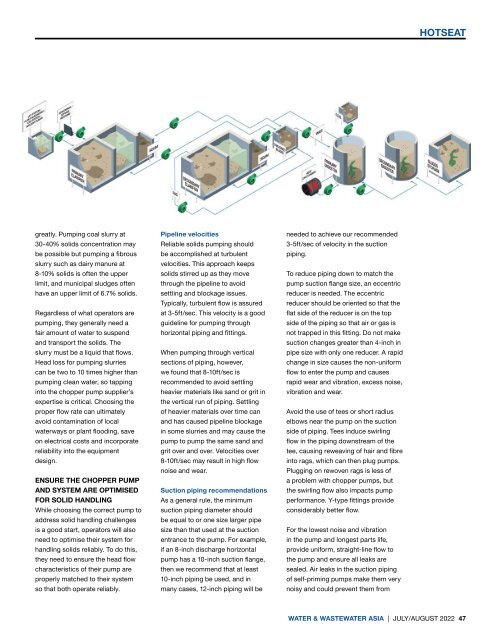Water & Wastewater Asia July/August 2022
Water & Wastewater Asia is an expert source of industry information, cementing its position as an indispensable tool for trade professionals in the water and wastewater industry. As the most reliable publication in the region, industry experts turn this premium journal for credible journalism and exclusive insight provided by fellow industry professionals. Water & Wastewater Asia incorporates the official newsletter of the Singapore Water Association (SWA)
Water & Wastewater Asia is an expert source of industry information, cementing its position as an indispensable tool for trade professionals in the water and wastewater industry. As the most reliable publication in the region, industry experts turn this premium journal for credible journalism and exclusive insight provided by fellow industry professionals. Water & Wastewater Asia incorporates the official newsletter of the Singapore Water Association (SWA)
Create successful ePaper yourself
Turn your PDF publications into a flip-book with our unique Google optimized e-Paper software.
HOTSEAT<br />
greatly. Pumping coal slurry at<br />
30-40% solids concentration may<br />
be possible but pumping a fibrous<br />
slurry such as dairy manure at<br />
8-10% solids is often the upper<br />
limit, and municipal sludges often<br />
have an upper limit of 6.7% solids.<br />
Regardless of what operators are<br />
pumping, they generally need a<br />
fair amount of water to suspend<br />
and transport the solids. The<br />
slurry must be a liquid that flows.<br />
Head loss for pumping slurries<br />
can be two to 10 times higher than<br />
pumping clean water, so tapping<br />
into the chopper pump supplier’s<br />
expertise is critical. Choosing the<br />
proper flow rate can ultimately<br />
avoid contamination of local<br />
waterways or plant flooding, save<br />
on electrical costs and incorporate<br />
reliability into the equipment<br />
design.<br />
ENSURE THE CHOPPER PUMP<br />
AND SYSTEM ARE OPTIMISED<br />
FOR SOLID HANDLING<br />
While choosing the correct pump to<br />
address solid handling challenges<br />
is a good start, operators will also<br />
need to optimise their system for<br />
handling solids reliably. To do this,<br />
they need to ensure the head flow<br />
characteristics of their pump are<br />
properly matched to their system<br />
so that both operate reliably.<br />
Pipeline velocities<br />
Reliable solids pumping should<br />
be accomplished at turbulent<br />
velocities. This approach keeps<br />
solids stirred up as they move<br />
through the pipeline to avoid<br />
settling and blockage issues.<br />
Typically, turbulent flow is assured<br />
at 3-5ft/sec. This velocity is a good<br />
guideline for pumping through<br />
horizontal piping and fittings.<br />
When pumping through vertical<br />
sections of piping, however,<br />
we found that 8-10ft/sec is<br />
recommended to avoid settling<br />
heavier materials like sand or grit in<br />
the vertical run of piping. Settling<br />
of heavier materials over time can<br />
and has caused pipeline blockage<br />
in some slurries and may cause the<br />
pump to pump the same sand and<br />
grit over and over. Velocities over<br />
8-10ft/sec may result in high flow<br />
noise and wear.<br />
Suction piping recommendations<br />
As a general rule, the minimum<br />
suction piping diameter should<br />
be equal to or one size larger pipe<br />
size than that used at the suction<br />
entrance to the pump. For example,<br />
if an 8-inch discharge horizontal<br />
pump has a 10-inch suction flange,<br />
then we recommend that at least<br />
10-inch piping be used, and in<br />
many cases, 12-inch piping will be<br />
needed to achieve our recommended<br />
3-5ft/sec of velocity in the suction<br />
piping.<br />
To reduce piping down to match the<br />
pump suction flange size, an eccentric<br />
reducer is needed. The eccentric<br />
reducer should be oriented so that the<br />
flat side of the reducer is on the top<br />
side of the piping so that air or gas is<br />
not trapped in this fitting. Do not make<br />
suction changes greater than 4-inch in<br />
pipe size with only one reducer. A rapid<br />
change in size causes the non-uniform<br />
flow to enter the pump and causes<br />
rapid wear and vibration, excess noise,<br />
vibration and wear.<br />
Avoid the use of tees or short radius<br />
elbows near the pump on the suction<br />
side of piping. Tees induce swirling<br />
flow in the piping downstream of the<br />
tee, causing reweaving of hair and fibre<br />
into rags, which can then plug pumps.<br />
Plugging on rewoven rags is less of<br />
a problem with chopper pumps, but<br />
the swirling flow also impacts pump<br />
performance. Y-type fittings provide<br />
considerably better flow.<br />
For the lowest noise and vibration<br />
in the pump and longest parts life,<br />
provide uniform, straight-line flow to<br />
the pump and ensure all leaks are<br />
sealed. Air leaks in the suction piping<br />
of self-priming pumps make them very<br />
noisy and could prevent them from<br />
WATER & WASTEWATER ASIA | JULY/AUGUST <strong>2022</strong> 47


















